At Roncesvalles, we had a fairly comfortable night in a 4-bunk cubicle. I took the top bunk, with Sharon below. The ladder was a challenge as it sloped in where it joined the lower bunk, so it was a bit like climbing a ladder from underneath. But once up there, I slept well, although my Garmin disagreed, saying my recovery was extended due to poor sleep. I thought the varying cadences of polyphonic snoring were actually quite settling.
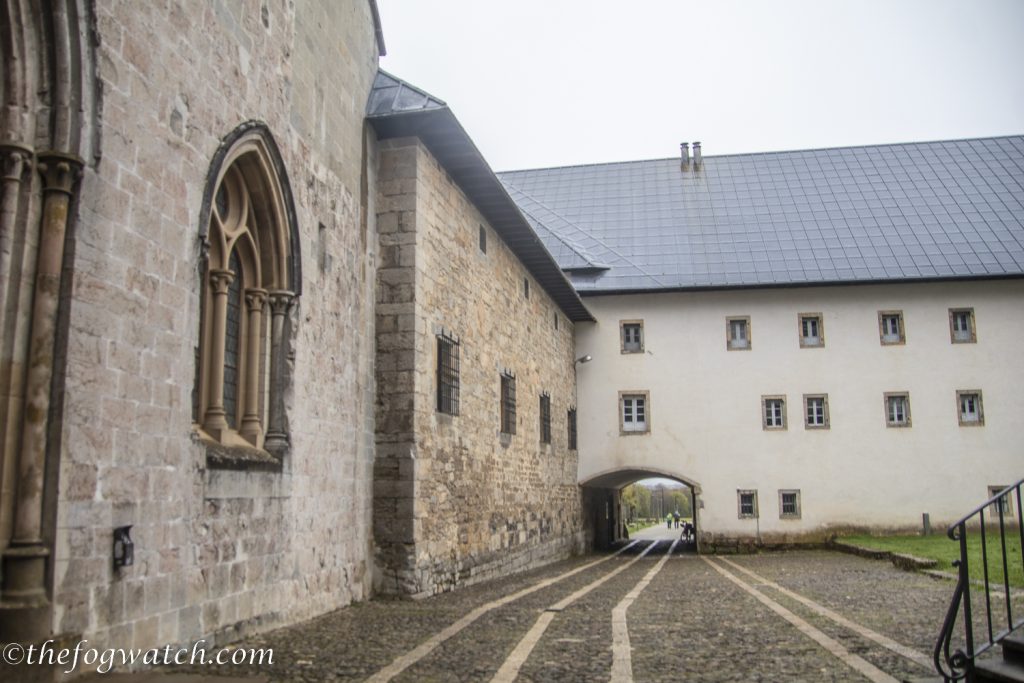
We were woken with guitar music, not the Gregorian chant we had had on previous stays, but still not a bad way to wake up.
There was an air of quiet haste as everyone packed up ready for their next leg — for some, it was straight to Zubiri, but we have learned from previous Caminos that taking it easy after the Pyrenees gives your body a chance to recuperate a little. Our goal today is just 6kms to Espinal.
A light drizzle outside saw us reach for the lightweight GoreTex jackets. We headed across to the bar-restaurant where breakfast awaited.
We were shown a table, then told we couldn’t sit away from the wall as it was a table for four. Breakfast was handed brusquely to us with cold toast, frozen butter, a bit of jam, a slice of processed ham, and a cheese slice. There was a yoghurt, an orange juice, an apple and a piece of supermarket cake. Technically, we could make coffee ourselves across the room, but by then we were hemmed in by two other pilgrims with associated backpacks. This did not look like a good start.
Marcus Aurelius in his Meditations, suggests that each morning we anticipate that we will meet grumpy people, so anything better than that is a bonus.
“Say to yourself first thing in the morning: Today I shall meet people who are meddling, ungrateful, aggressive, treacherous, malicious, unsocial. All this has afflicted them through their ignorance of true good and evil.”
[Marcus Aurelius: Meditations, Book 2/1]
He goes on to the effect that their issues are not my problem.
“We were born for cooperation, like feet and hands, like eyelids, like the rows of upper and lower teeth. So to work in opposition to one another is against nature: and anger or rejection is opposition.”
[M.A: Meditations, 2/1]
I wondered about that, and began to think unpilgrim-like thoughts towards Marcus Aurelius. Like who does he think he is? Ok, I mean aside from Roman Emperor. Yeah, and philosopher. Okay, so he was a General. But I mean, it’s not like he would care — he’s a Stoic after all. A dead one, an ex-Roman Emperor. Even the daisies he pushed up have been built on more than a hundred times. So Marcus, what do you think of that? Eh?
And no, Epictetus, don’t you start. What do you mean just focus on what I can control? Are you seriously telling me that if I want to be a Stoic pilgrim, I should just…?
I drank the orange juice, picked up the yoghurt and the apple, and abandoned the rest of breakfast as a bad idea. We shouldered our packs and went out into the cool drizzle. I was already warm from my darkened mood, but I looked around at the monastery, the morning mist, and the green trees in the background. I sighed deeply. The day will surely improve after this.
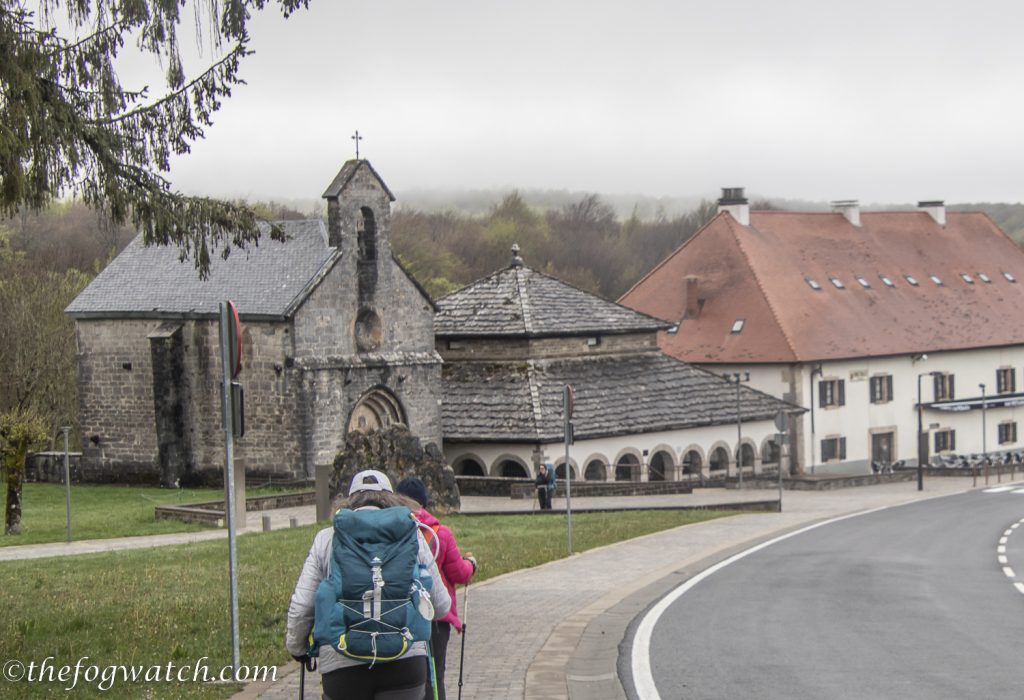
I looked across at the Capilla de Santiago – the Santiago chapel. It is an early C13th gothic chapel and we had been told that the bell was rung at night to guide pilgrims caught after dark on the Ibaneta Pass through the mountains. Curious, I went in. The chapel is small, built from plain stone with alabaster windows, narrow and pointed. I thought of our breakfast server.
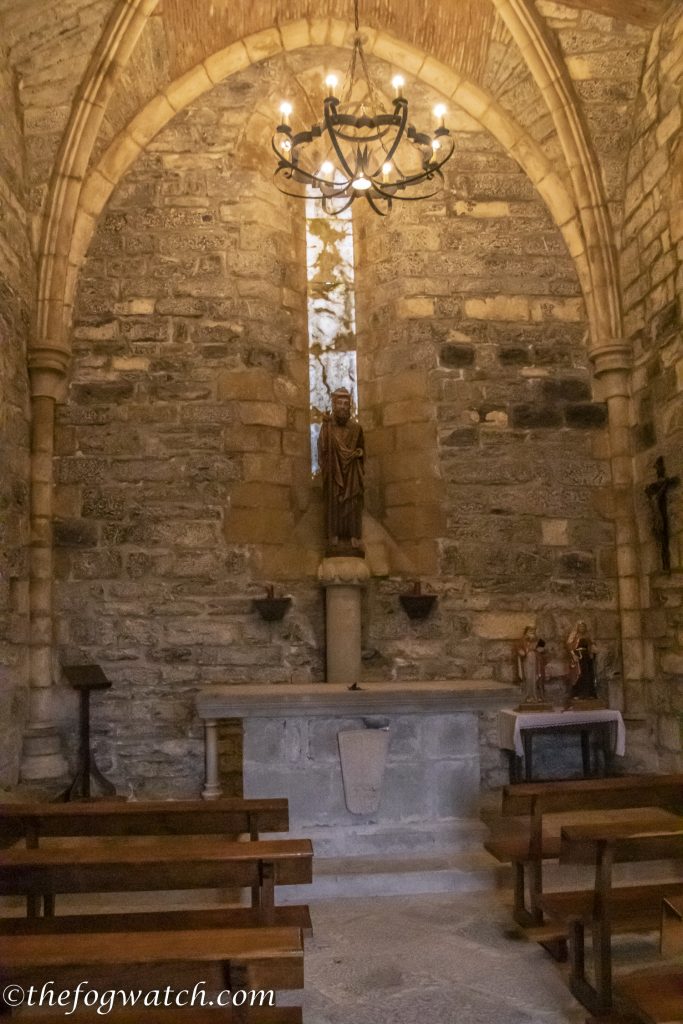
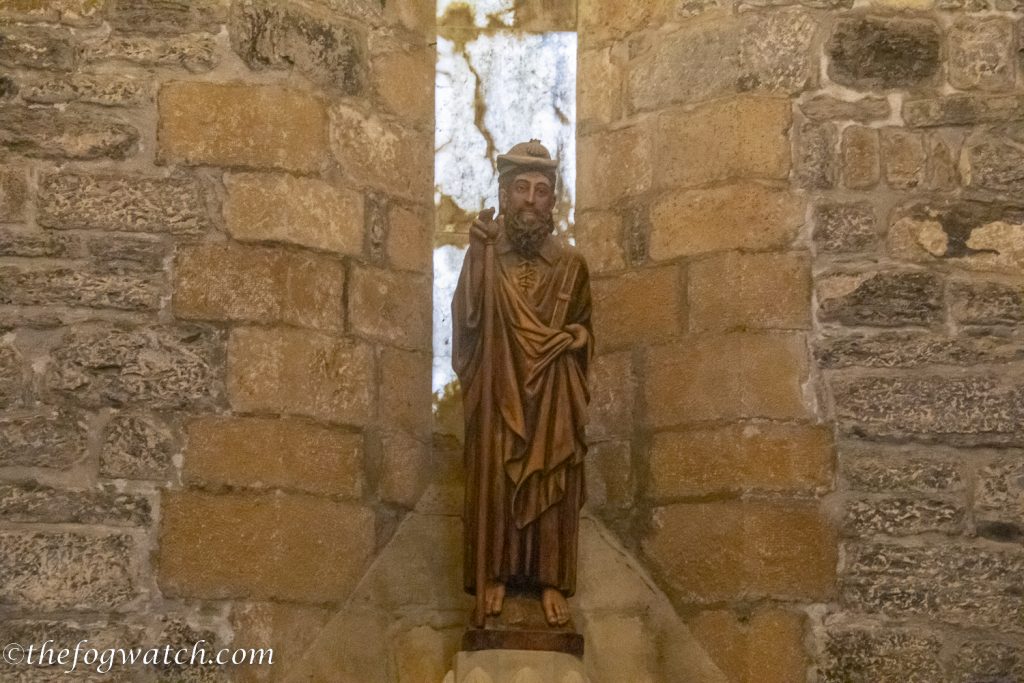
The chapel was bathed in a warm light, and a statue of St James (Santiago) as a pilgrim stood on a plinth behind the narrow altar. He bore a gentle smile, as if to say: ‘All this will pass, just let it go.’ “Don’t you start, mate,” I thought.
Then I thought about the pressure the bar restaurant had been under over the past two years of pandemic lockdowns and no pilgrims for months at a time, and the pressure to serve a hundred meals in a place that seats about 25. I nodded and thanked St. James for the gentle reminder. It is time to think more like a pilgrim and less like a first-world tourist. It takes time and practice to build a habit of thought. And I was at the start of my journey. Slowly, I began to relax, and pushed my unkind thoughts aside. Here in the chapel, I am not hassled; here it is peaceful.
I recomposed myself, before heading out with Sharon to resume our journey. There was a light drizzle but I was warm and comfortable. The pack felt good and I set off with a light step.
We stopped at the famous “Santiago de Compostella 790” sign and a fellow pilgrim took our photo next to it. I returned the favour, and with that, we headed into the birch woods.
The path is well made and crunched satisfyingly beneath our feet. The gravel is new and clean stretching away like a ribbon through the trees. We held back a little to give the early crowd from Roncesvalles a chance to space themselves out. I looked off to the side into the forest. In the C16th there was reputed to be a witches’ coven based here — perhaps they were just a group of teenagers sneaking out for a smoke without the gaze of their parents, or perhaps they were critical of the deeply patriarchal society in which they found themselves. Or perhaps they were simply knowledgeable herbalists and midwives. For nine women, the association or accusation cost them their lives, burnt at the stake. Today the witches’ wood is tranquil and green.
About two kilometres on we found the Cruz de Blanco — the White Cross — set up supposedly to prevent witches from entering the village of Burguete. As we entered the village we admired the street art depicting the history of Auritz Burguete — including its dark association with the witchcraft trials.

There is a new bar at the entrance to the village, and here we had a superb proper breakfast with an excellent pot of tea. Now, this is the way to start the day on the Camino!
We stopped in at the local supermercado where we were warmly greeted with “Welcome to Basque country”. Our mission was to buy some bananas (Quiero dos plantanos, por favor), and duly supplied, we continued on through the village.
Burguete is at the confluence of two rivers — the Rio Arce and Rio Urederra. The name Burguete itself is a contraction of its original name ‘Burgo de Roncesvalles’ as it is on land once owned by the monastery.
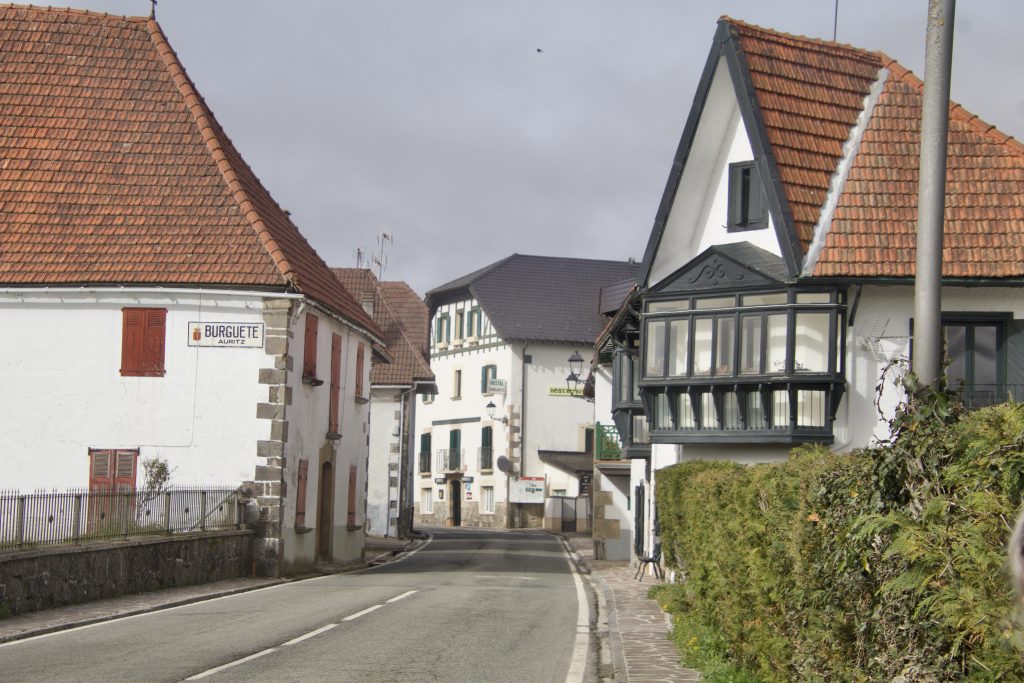
Burguete is popular with tourists for two reasons, firstly, it is apparently a great trout fishing location, and secondly, Ernest Hemmingway stayed here in 1923 and 1924 for the trout fishing, and describes the village in his book The Sun Also Rises:
“As we came to the edge of a rise, we saw the red roofs and white houses of Burguete ahead strung out on the plain, and away off on the shoulder of the first dark mountain was the gray metal-sheathed roof of the monastery of Roncesvalles.”
[Hemmingway, The Sun Also Rises, p.21]
He stayed at the Hostal Burguete which is still here today, along with the piano on which it is said he scratched his name and the date “25-7-1923”. The novel continues its description:
“The houses of Burguete were along both sides of the road. There were no side-streets. We passed the church and the schoolyard, and the bus stopped. We got down and the driver handed down our bags and the rod-case… We went up the street, past the whitewashed stone houses, families sitting in their doorways watching us, to the inn.”
[Hemmingway, The Sun Also Rises, p.21]
Apparently, the Hostal serves a Hemmingway soup — a vegetable broth apparently like the one served to Hemingway and his companions.
He had taken the bus there from Pamplona, whereas we had walked from Valcarlos. We continued up the street past the bakery — which exuded delicious baking smells, and we chatted about the path we had taken from Charlemagne’s namesake town. Ironically, it’s the Napoleon route on the high pass that has Roland’s fountain, but in reality, he would have taken the lower pass. I can barely imagine taking a whole army over the Valcarlos route — it was hard enough with the two of us and our backpacks, let alone horses and full military gear of the time. The troops would have reduced the path to a quagmire in no time.
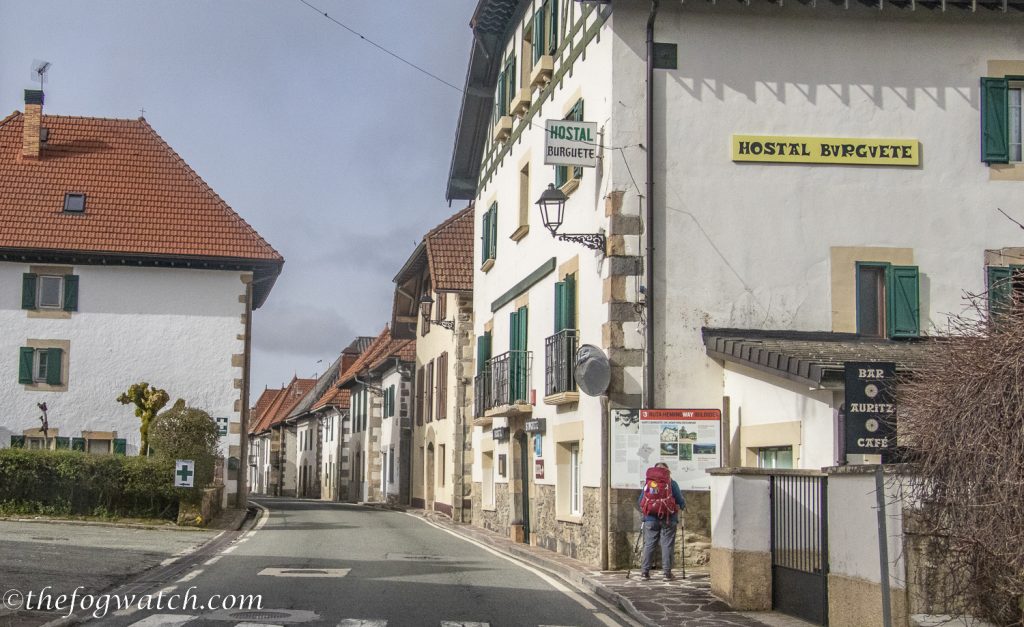
Nearby is a site traditionally identified as the site of the massacre of Charlemagne’s troops at the Battle of Roncesvalles by the Saracens. The Valcarlos route is named for the pass Charlemagne’s army took across the Pyrenees. On their retreat, the pass narrowed so that half of the army was over the top, and the rear was strung out, overseen by Charlemagne’s flag-bearer, General, and nephew, Roland. They were ambushed out of the woods and massacred before Charlemagne was even aware of the attack. Roland was killed in the struggle. There are conflicting accounts, and numbers in medieval chronicles are often grossly inflated to raise the story to an epic scale.
Pseudo-Turpin’s account in the Codex Calixtinus tells us:
“While Charlemagne, Ganelon, Turpin, and 20,000 Christians were crossing the pass, 20,000 others were forming the rearguard under Roland at Roncesvalles. When they, too set out to cross the pass, Marcilius, Beligrand, (both Moslem captains) and 50,000 Saracens sprang from the hills and forests. They divided themselves up into two units, the first made up of 20,000 men and the second of 30,000. The first immediately attacked our men from the rear, causing them to turn quickly and to fight from sunrise until nine in the morning. All of the saracens were killed. Immediately, however the other unit of 30,000 attacked our men who were already tired from such a huge battle, and killed every last one of them. Not one of the 20,000 Christians was saved.”
[The Chronicle of Pseudo-Turpin, Book IV of the Liber Sancti Jacobi (Codex Calixtinus) — C12th]
The reality was probably closer to a skirmish with local Basques who had been treated poorly by Charlemagne’s army as they had advanced into Spain. The Basques are fiercely independent people, and may have initially just seen Charlemagne as a means to drive out the moslem Saracens. I doubt their allegience would have extended further. While Charlemagne succeeded in driving a path right across Spain to Santiago de Compostela, Soldiers in Charlemagne’s army took advantage and looted as they went. This caused resentment among the locals, and word would have quickly spread across Navarre back to the Basques, who knew their own country well. According to Einhard (775-840), a Frankish scholar who wrote a Life of Charlemagne, he describes the attack as an example of Basque betrayal:
“While [Charlemagne] was in the Pyreneean mountain range itself, he was given a taste of Basque treachery. Dense forests, which stretch out in all directions, make this a spot most suitable for setting ambushes. At a moment when Charlemagne’s army was stretched out in a long column of march, as the nature of the local defiles forced it to be, these Basques who had set their ambush on the very top of one of the mountains, came rushing down on the last part of the baggage train and the troops who were marching in support of the rearguard. The Basques forced them down into the valley beneath, joined battle with them and killed them to the last man. They then snatched up the baggage, and, protected as they were by cover of darkness which was just beginning to fall, scattered in all directions, without losing a moment. In this feat the Basques were helped by the lightness of their arms and by the nature of the terrain in which the battle was fought. On the other hand the heavy nature of their own equipment and the unevenness of the ground completely hampered the Franks in their resistence to the Basques.”
[Einhard: Life of Charlemagne, p.68]
Whatever the truth, the passes to Roncesvalles have been written into history — a story that is now part of our own as we walk through this land.
We headed up the main and only street of Burguete, before seeing arrows sending us off to the left side of the town out into open farmland. We crossed a stream forded by an ancient stone bridge, which comprised one large stone with a step crudely hacked out at either end.
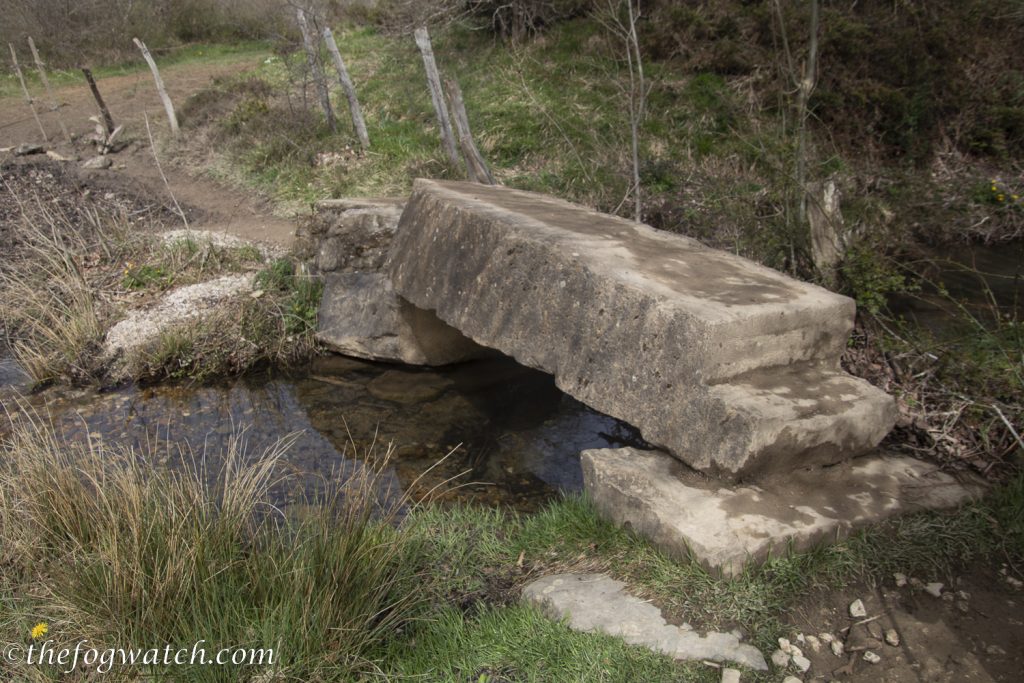
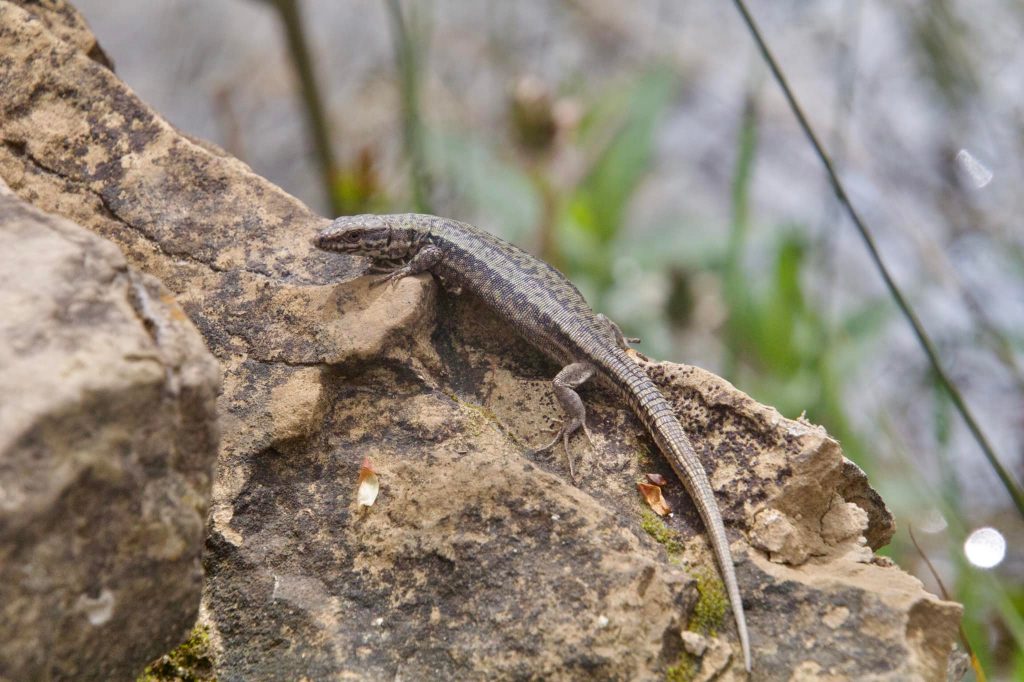
I saw a small lizard about 30cm long on the rock, and after negotiating the muddy creek we continued on a fairly solid path. Horses grazed in the paddocks off to the side — they were stocky, like small versions of a Clydesdale. I watched a farmer offload some feed from his tractor, then he realised the gate was open and one of the horses was making his escape. The farmer sprinted — as much as one can sprint on muddy furrows — but in the nick of time, he reached the gate just in time to turn the horse aside. I was surprised at the speed and agility of both the Basque farmer, and the horse!
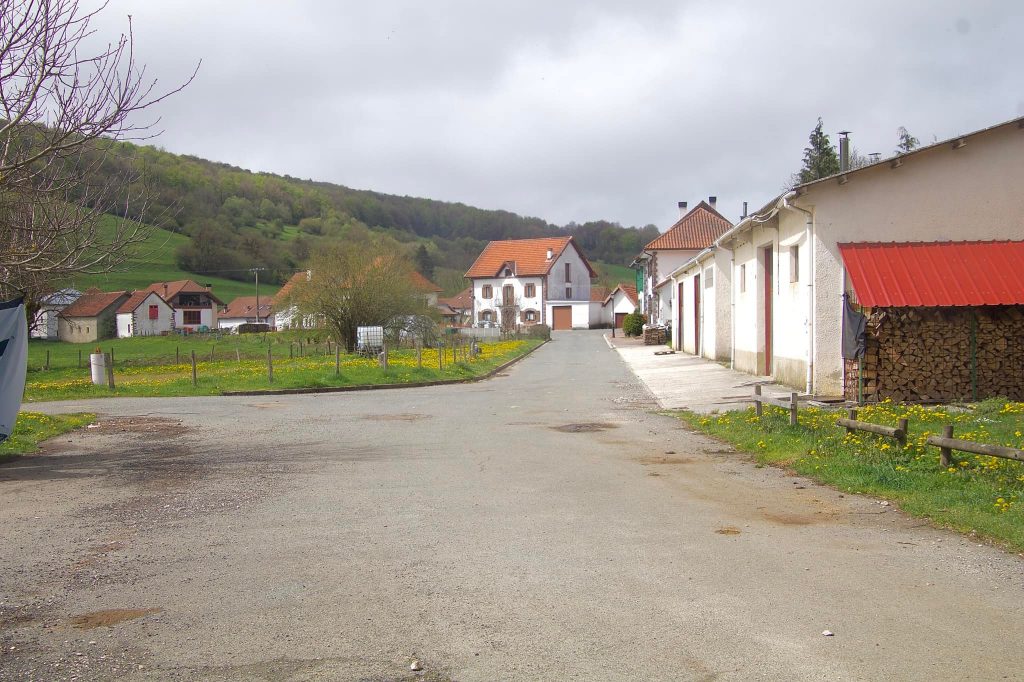
The track took us into Espinal — soon we could see the wide square that formed the entrance into the town. On the left the large stack of milled timber was festooned with clothing — underwear, base layers, shirts — a pilgrim had been camping out and had been soaked by the rain. He was now trying to get everything dry. I wished him luck and continued into the town to find our casa rural.
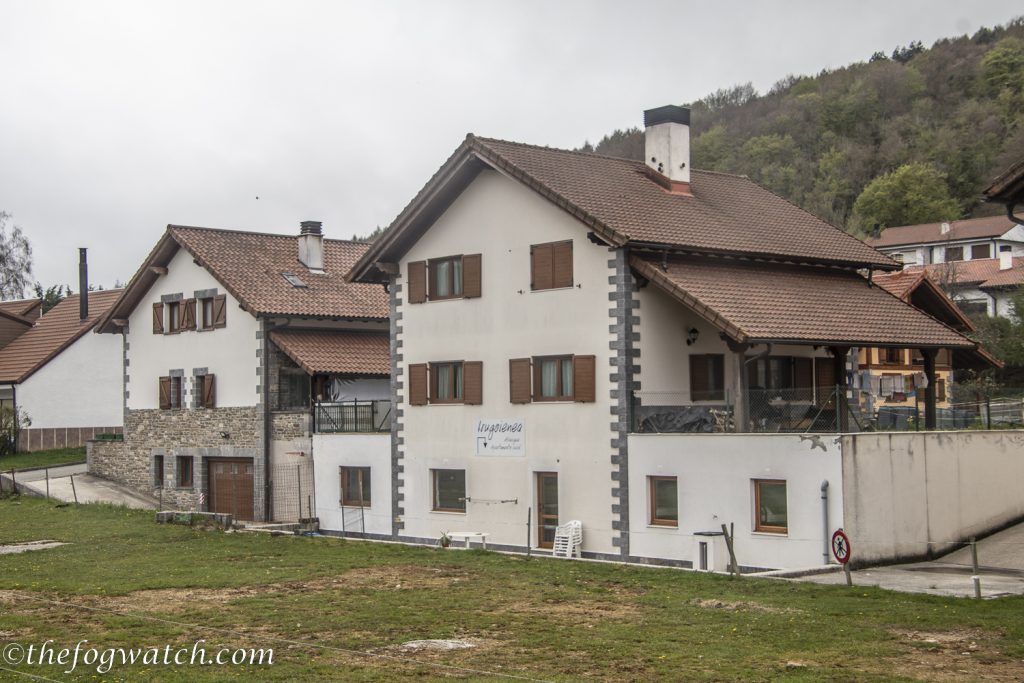
There was no sign of life at the hostel — indeed it looked as if it had been unoccupied for some considerable time. I wondered if it had closed down and gone out of business since our booking. Despondent, I consulted my booking confirmation and saw that the place opened at 5.00pm. So we decided to find a bar and at least have some lunch. We walked the entire length of the town, about a kilometre and back — nothing was open. Eventually, I saw what might have been a donativo stall, and went to see if they had any food — it was a handcraft and preserves stall, but the woman pointed us back the way we had come and said there is a bar over near our accommodation that should be open. So we headed back, and sure enough, it was not only open, but very welcoming. A couple of locals were sitting outside, looking up as we went in. We were able to get a fine lunch and coffee, and we waited there, chatting about what we had seen so far, until around 5.00 pm when we decided to try our luck again.
Walking down the street, I saw a Brown Kite swoop down, before taking off and circling around us as he climbed. Perhaps it was a good sign.
This time there was a car parked out the front, and a young Italian woman bustled us inside. She explained that she would be managing the Albergue part from Sunday, but the owner would come over later to formalise the booking, however, she could show us around as they were just opening up for the season. The Albergue section downstairs would open in a few days, so we were the only ones staying there, or so we thought.
The place had a washing machine, so we could get that started, and we could settle into our room. We were told that because they weren’t properly open, they had no means of providing food, but the bar where we had lunch could do our dinner from around 7.00 pm.
We showered, dressed in our tomorrow’s clothes and hung out our newly washed clothes — the day looked good for drying as we caught the last two hours of sun. The owner arrived, and welcomed us as the first guests of the season, and so we paid and signed in. He stamped our credencials before departing. Then it was back to the bar across the way and time for a celebratory wine before dinner. Later another guest arrived, but we only heard him or her settle into another room. They were gone before we got up, so we never actually met. And so to sleep ahead of a challenging walk tomorrow.

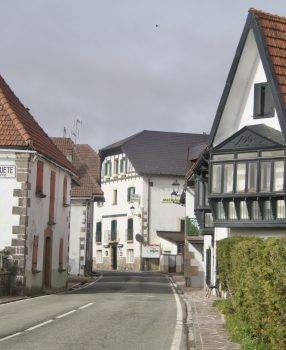
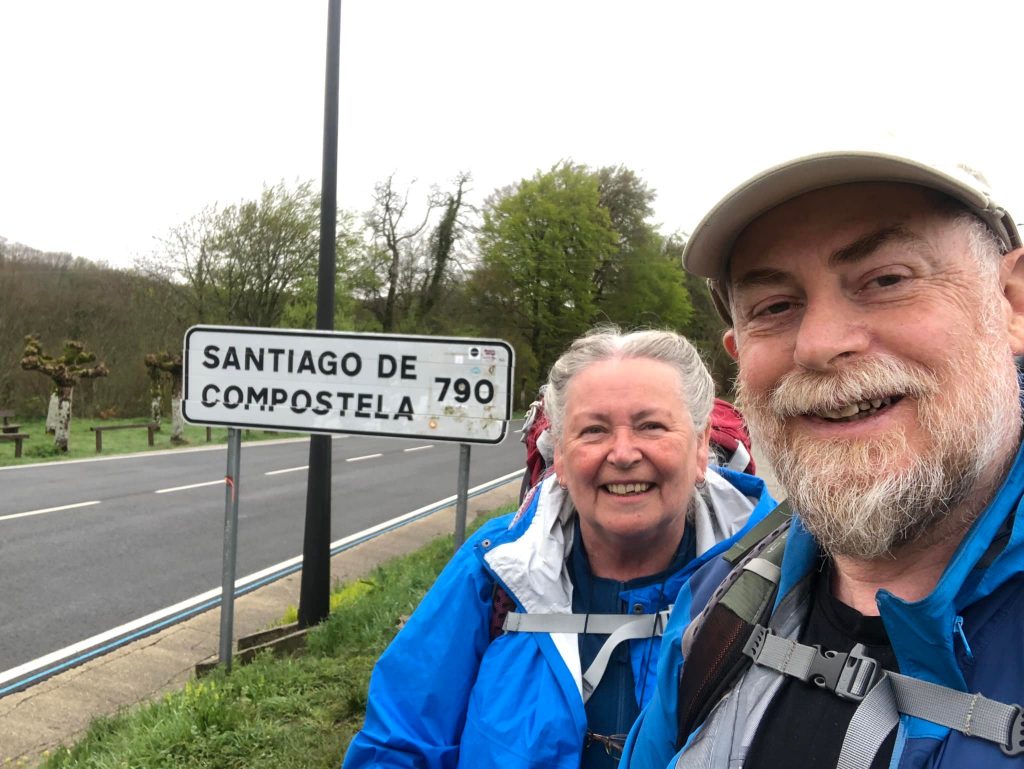
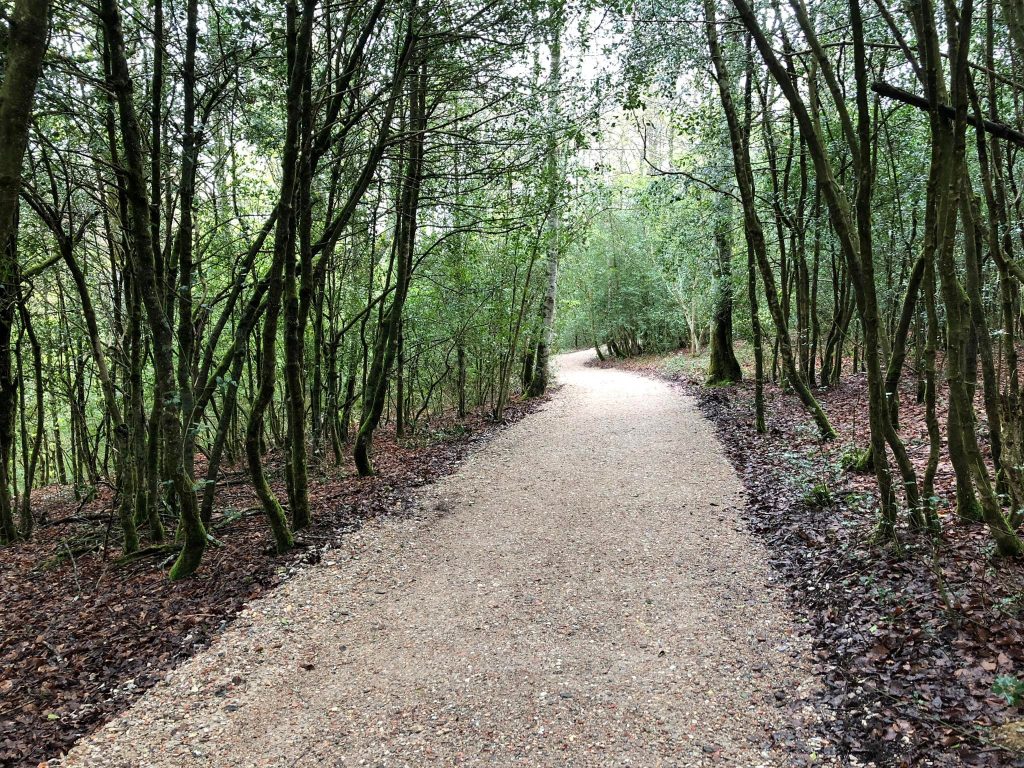
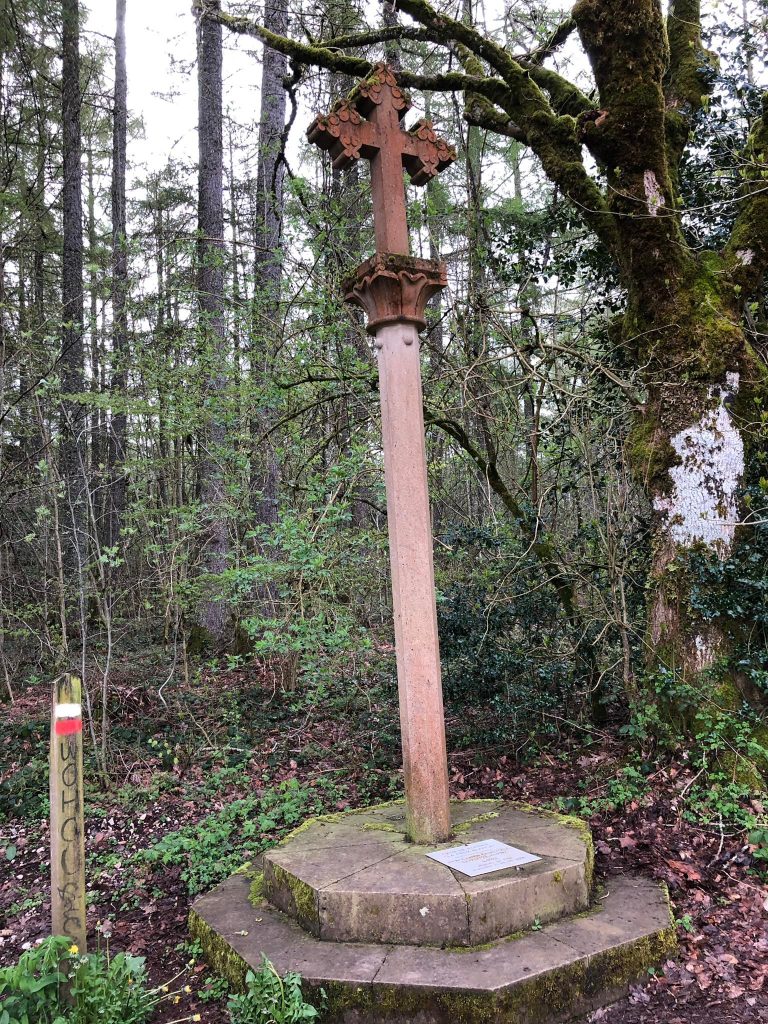
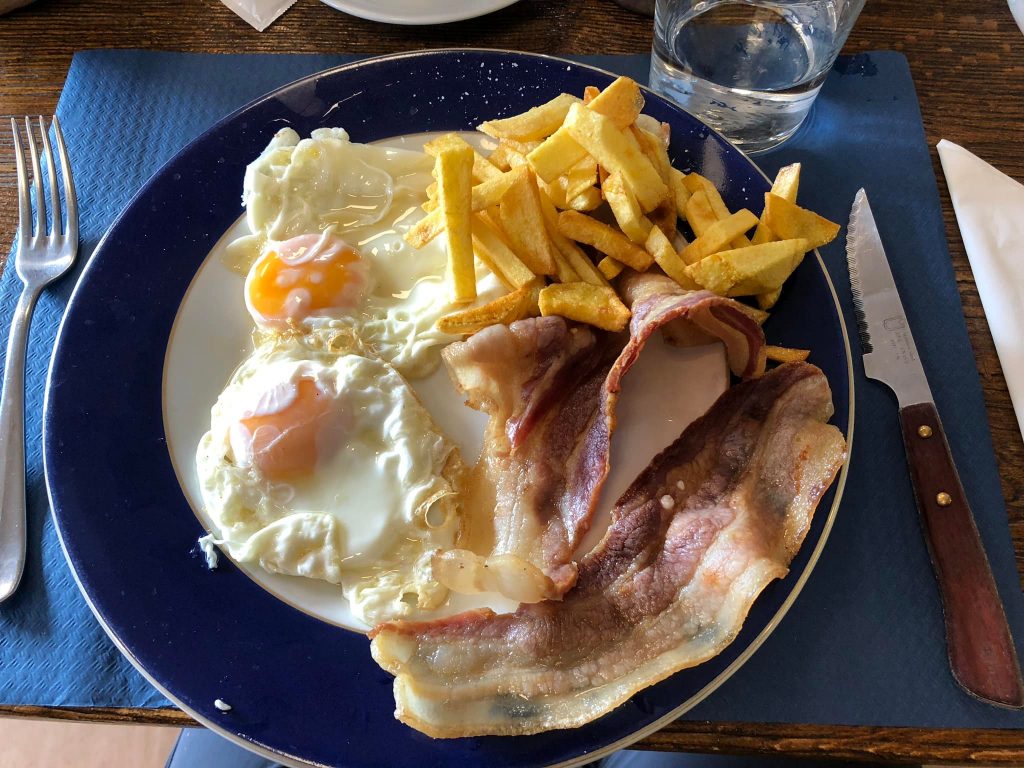
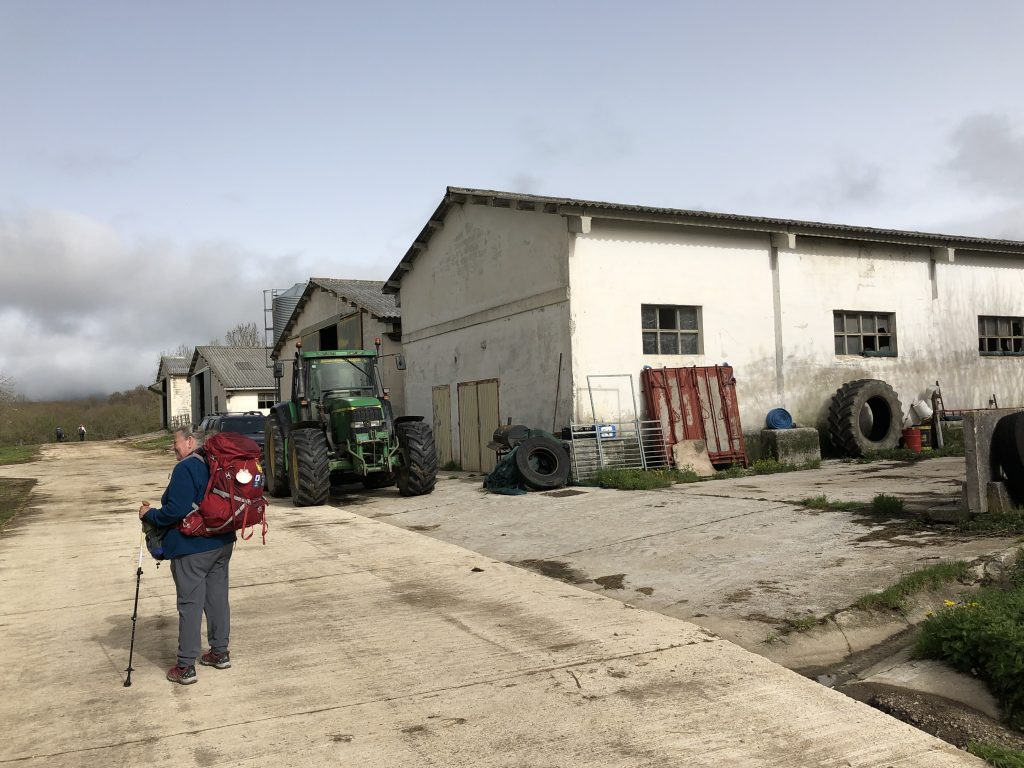
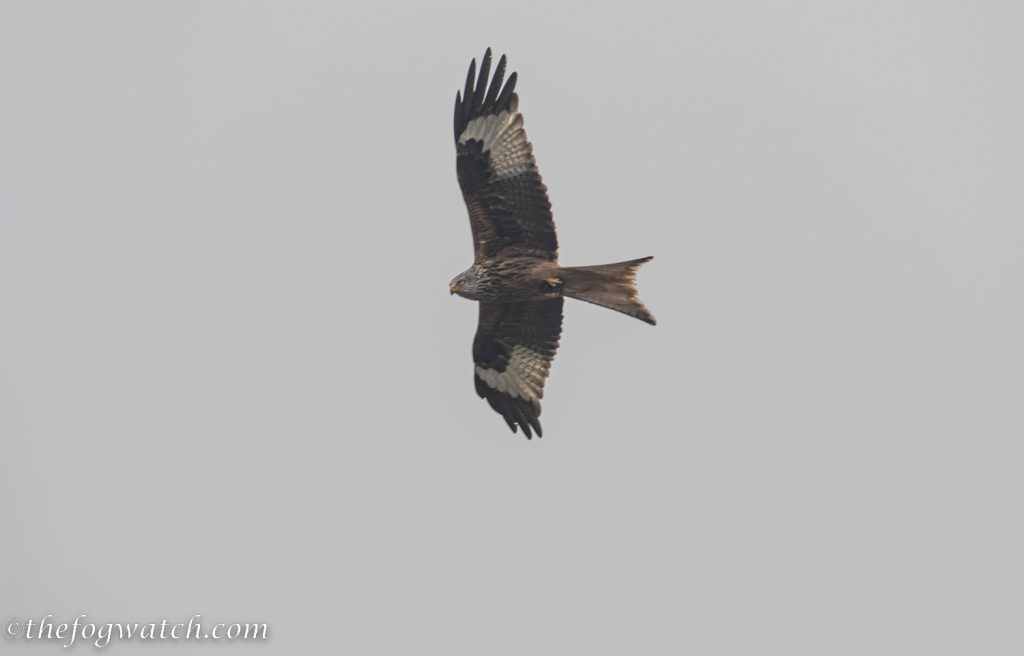
Evening Jerry and Sharon
What wonderful prosaic bloggery.
Last Oct we spent a few days exploring the valley upstream of the stepping stones btwn Espinal and Bar Juan ( you’ll know it). Someone has stencilled letters on the concrete block stepping stones. Pilgrims stride over them but you need to pause for a cuppa to notice the letters spell…DEBORDER. In French, that means to overflow. As in “my cup runneth over”.
At the source of the river Sorogain, there is a ridge and you can look back towards Franco-Spanish administered Quinto Real/Aldudes.
Nearly a year ago. We had late-October blue skies and autumn golds in the beech forests.
We wish you and Sharon all the best as your re-Camino unfolds.
From two britannico-Australo frogs near Nantes.
Alan and Shirley
Thanks, Alana and Shirley — yes we know Bar Juan well, and the cement block stepping stones — I love the idea of them spelling out ‘My cup runneth over’!
We also loved Nantes when we visited there a few years ago — amazing park and of course the famous Machines de l’ile — such an artistic and creative place 🙂 Buen Camino
Jerry and Sharon 🙂